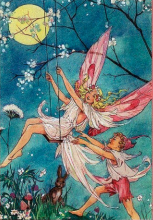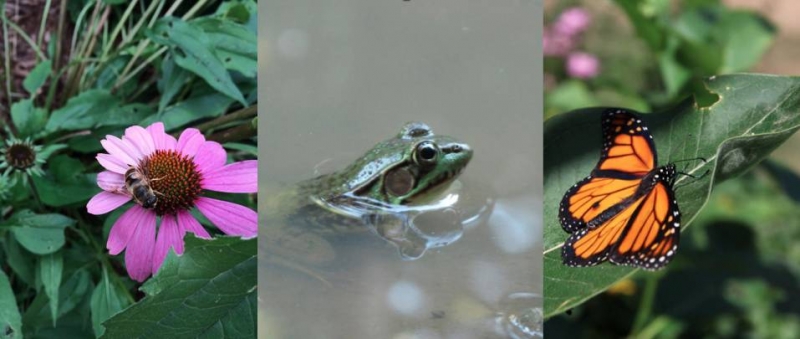
Our fairy friends Blossom and Thimble reveal where they go in winter and share their knowledge about frogs, bees, and butterflies.
Ask a Fairy Part 2: Fairy Food, Autumn Leaves, and Migration
Our fairy friends Thimble Hickory and Blossom Dewdrop are back to answer the rest of your questions about North Country nature and the lives of fairies. While they're settled into the warmth of the tropics for winter, they're already excited to return to Canton, NY next fall!
Click here to read Thimble and Blossom's responses in Part 1.
Why do tree leaves change color? (Lucy, age 5)
Hi Lucy,
When summer is ending and fall is beginning, the days get shorter and the nights get longer. According to my fairy friends, the trees are very sensitive to this change, and it makes them stop sending important minerals, the fuels that help the tree look big and green, to their leaves. When the minerals aren’t being sent, the trees stop producing chlorophyll (klor-o-fil). Chlorophyll is the coloring that makes the leaves green, like how green food coloring makes your eggs and ham green on Dr. Suess Day. Now that the chlorophyll isn’t being created, the tree makes xanthophylls (zan-tho-fils) and carotenoids (care-o-ten-oids). These scientific words describe the yellow and orange colors the leaves have. Anthocyanins (an-thuh-sigh-nins), the red and purple colorings of the leaves, are made from the sugars kept inside the leaves, and they help protect the tree leaves from animals that hunt for food.
Why are some trees poisonous? (Jack, age 4)
Hi Jack,
According to my fairy friends, some trees are poisonous because they need a reaction that helps protect them and makes sure they survive. Since they can’t run away from animals that might eat them, they need to produce poisons that fight them off. For example, my fairy friends who live in South America always stop in manchineel trees. These trees have poisonous apples and spikes on their leaves to stop animals from eating them. One poisonous plant here in the north country is milkweed. Milkweed has white sap that is dangerous to animals like deer and cows. However, milkweed is not poisonous to many insects, and it is the favorite food of monarch butterfiles!
Why does moss grow on rocks and trees? (Sophia, age 2)
Hi Sophia,
Moss grows on rocks and trees, because it likes places that are damp and shady. Moss needs moisture to grow, and when sides of the rocks and trees are hidden from the sun, it blooms. My favorite moss to stay in is the goldenleaf campylium, because it feels like a very comfy bean bag. Here are some more facts about moss that my friends put together: http://www.softschools.com/facts/plants/moss_facts/504/.
What kinds of frogs live in these woods? (Devin & Sarah, 20 yrs old)
Hello Devin and Sarah! I am so happy you asked about frogs. They are fantastic friends to have!
There are several different species I’ve come across in the woods of the North Country. I’ve had the pleasure of meeting bullfrogs, leopard frogs, green frogs, gray tree frogs, mink frogs, wood frogs, and pickerel frogs. When you spend enough time around them, it is very easy to tell the difference between the many frogs. Some have spots, some are all one color, and they all have different songs they like to sing. Some sing with pretty voices, some sing quietly, and others sing very loudly. My friends at the New York State Department of Conservation helped me identify them all, and if you want to learn more, they are a fantastic resource!
Have a fantastic fall and winter, and I hope to see you in the spring!
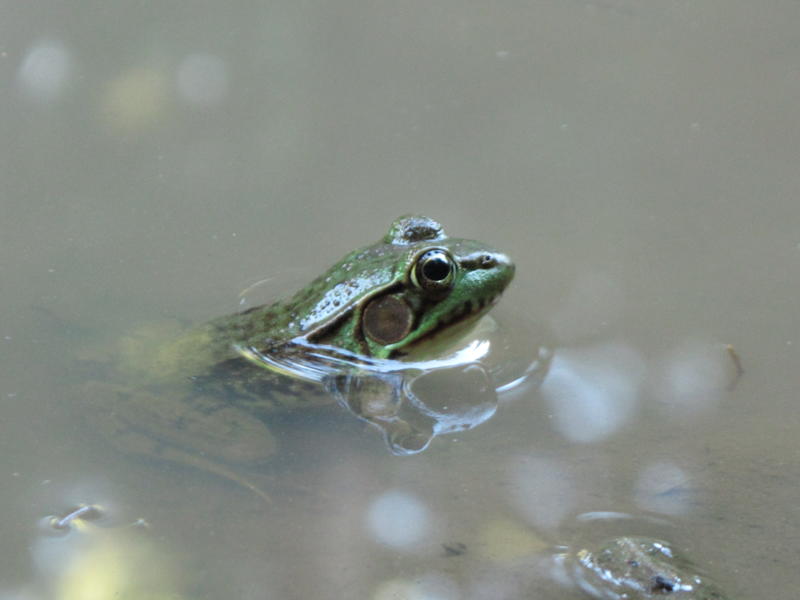
Mink Frog. Photo: Claire Jenkins, natureupnorth.org
Why are leaves green? (Alex and Dan, 6 and 7 yrs old)
Alex and Dan, what a great question! My fairy friends and I love to make beds and clothes out of leaves, so I know a lot about them. The pretty green color of leaves comes from a fancy chemical called chlorophyll. Chlorophyll is like green paint, and is inside of leaves to help the plant or tree suck up as much energy from the sun as it can! Without the green chlorophyll, we would not have any plants or trees, because they couldn’t get enough sun to grow. So, every time you look at green leaves from now on, I hope you say, “Thank you!” to chlorophyll for letting us have trees to climb and flowers to smell.
Do you have any fairy pets in your house? (Mae, age 9 ½)
Hiya, Mae! I’m glad you asked about our pets. We don’t have dogs, cats, or even goldfish as pets. Instead, we have cute little insects called aphids. Their names are Spot, Buster, Abigale, and Jenny. They are small, green, and they love to make honeydew for us fairies to eat! Aphids drink sap, which is a sweet liquid that flows under a tree’s bark. The sap helps the tree by moving food and water around to the parts of the tree that need it. After the aphids drink the sap, they turn that sap into honeydew, which is even yummier than sap, by pushing it through their special stomachs. It is our favorite snack because it tastes like candy!
Are you guys friends with the frogs or are they your pets? (Sarah, age 6)
Dear Sarah,
Thank you for your question! My fairy friends and I are very good friends with our frog neighbors. Frogs are very smart and they like to live on their own, so they wouldn’t like to be someone else’s pet. We have tea parties and go swimming together. They are very fast swimmers! At our tea parties, we sip mint tea and eat our favorite snacks. Our best frog friend, Norbert, loves eating flies. We tried them, but they weren’t very good!
How do birds find food? (Gina, age 33)
Hello Gina,
Birds use their super senses to find food. Many birds have much better hearing and sight than people, so they use those senses to find their food. My friend, Alison the cedar waxwing, uses her amazing vision to see her favorite food—berries—while soaring overhead! Then she flies down and plucks a bunch off the trees. Her favorite are Mulberries! Yum! Another friend of mine, Randy the barred owl, hunts in a different way. Owls have really good eyes that help them see at nighttime. That means that Randy can see even in complete dark! He uses his night vision and his super sharp talons to catch rats that are scurrying around at night.
Why do some birds eat worms and some eat seeds? (Roman, age 4)
Hi Roman,
Birds eat many different kinds of foods because of the way they are shaped! My friends, the robins, have straight and pointy beaks that are perfect for picking worms out of the ground, while my best friend, Kareena the cardinal, has a short and thick beak that is perfect for cracking and eating seeds. Some birds eat other things though, like Andrew the turkey vulture. He eats dead animals! You might think that this is gross, but it’s his favorite food because he has a super strong belly that keeps him from getting sick! He’s the best, because he keeps the streets clean when there’s a gross dead animal on the road!
Where do fairies go south? (Madison, age 11)
How far south do you go? (Hunter, age 4, and Brantley, age 2)
How long does it take to travel south? (Darvey, age 8)
Hey Madison, Hunter, Brantley, and Darvey!
In the winter we leave the Canadian Forest to go south because it’s too cold, and we like to go see all of our family and friends that live up and down the East Coast! It takes us about 2-3 months to make it all the way to our final destination in the Amazon Rainforest in Brazil where we go to see our friends, the Rain Forest Fairies! It takes us so long to get there because we stop along the way to see all of our friends. We make our first stop here in Canton to visit our forest friends, like the deer and the songbirds! We see the ocean fairies on the New Jersey coast. The Palm Tree fairies in South Carolina, and the Retired fairies in Southern Florida before finally going to the rain forest to spend the winter!
What is fire? (HKS)
Hi HKS,
A very long time ago fire was discovered by the first fairies, and since that time fire has been really important for our existence. It warms us when it is cold outside, we can use it to cook food, and we can also use it to see in the dark. But what is fire? Fire is not an object; it is actually a process. It is the result of a chemical reaction. A chemical reaction is similar to mixing two different colors to make a new one. To create fire, we need fuel (something to burn) and enough heat and oxygen. Mixing those three elements releases light, heat and sound. Fire can be good for nature as long as it is small and controlled, since it can kill certain diseases that attack trees. It can also provide the soil with nutriments, which is really important because nutriments for the soil are like food for humans and animals. Keep in mind that fire is also really dangerous and you should never approach it without an adult.
Why do frogs like water? (Jack, age 4)
Hi Jack,
Frogs are called amphibians, which means they can live in water and on land. Frogs love water, because it is the place where their babies, what we call tadpoles, grow up. Also, frogs can find their food like insects and small fish in or around water. Although some kinds of frogs, such as Bullfrogs and green frogs, like water more than tree frogs and toads, all frogs like water and go to it at some part of their life.
What do you do when you dance and sing? (Mae, age 9)
Hi Mae!
When I dance and sing I always like to have lots of fun! I love to spin around and jump from tree to tree with Thimble, my best fairy friend, and the animals that live in the forest. I especially enjoy dancing with my squirrel friends, because they are so good at jumping! I always sing loud and proud, and I like making up songs about all the wonderful things in the nature of the North Country, such as the lovely sugar maple trees and the white water lilies! My favorite animal friends to sing along with are the American goldfinches! They are small, black and yellow birds, with beautiful singing voices, and I would definitely recommend listening for them!
What color are your dresses? (Ethan, age 4)
Hi Ethan!
Today the dress I am wearing is blue with yellow flowers all over it. I have many different types of dresses that are all different colors of the rainbow! My favorite dress is one I made from the leaves that fell off the sugar maple trees last fall! It is a bright red, orange, and yellow dress! My chipmunk friends are especially helpful when it comes to collecting materials for my dresses. They are so good at running quickly around the forest!
How are flowers pink and purple? (Avery, age 3)
Hello Avery!
When flowers are growing they have a natural paint in them called pigment. The pigment makes flowers all different colors! Flowers like to be pink and purple because some bees love pink and purple! When a bee likes the color of the flower, it will visit it! It is important that flowers are colors that bees like, because flowers need bees to help them grow!

Photo: Carol Wright, natureupnorth.org
How do bugs eat, and fly? How do you climb? (Mae, age 9)
Hi Mae!
Different bugs like to eat different ways! Some bugs like to chew their food, while others have straw like tongue, and they like drink their food! Some bugs are born with wings attached to their muscles. When the bug uses its muscles to move its wings, the bug can fly! Some types of bugs, like cockroaches, can’t fly because they do not have wings. Like some bugs, I have wings, too! I never need to climb, because I can fly to the tops of the trees where I sleep!
Where can I go nearby to see the Milky Way? (Lorraine)
Hi Lorraine!
If you live in the North Country, you already have an advantage to seeing the Milky Way! Stargazing is much better when you are away from large cities with lots of lights. The best time to look at the stars is outside at night when there is no moon. I suggest going out to lie in an open field, such as the St. Lawrence University Golf Course in Canton or Lehman Park in Potsdam, while the weather is still nice. But the farther you can get from town, the better!
How do you take baths? (Mae O’Shea, age 9, HKS, and Logan, age 9)
Hello Mae, Logan and HKS,
Fairies love taking baths! We like to twinkle throughout the night when flying across the forest in the dark. In order to stay extra sparkly, we take baths in rivers, lakes, or even drops of water on tree leaves. We always use biodegradable soap to wash up, which means the soap doesn’t harm the environment. We use the nectar from flowers as shampoo to clean our hair. Sometimes the fish will even blow bubbles in the water, and we can have bubble baths! We don’t have to worry about lakes or rivers being frozen in the winter, because we go down south where it is mostly warm all year.
Do butterflies eat with their feet? (Lainey, age 3)
Hi Lainey,
Butterflies do not eat with their feet, but they can taste with them! Butterflies can tell what their food tastes like by just landing on it, because their “taste buds” are on their toes! However, butterflies drink flower nectar from a tube called a proboscis in their mouths, which is just like drinking from a straw. Butterflies mostly like to drink nectar, but they will also eat dung, pollen, tree sap or rotting fruit.
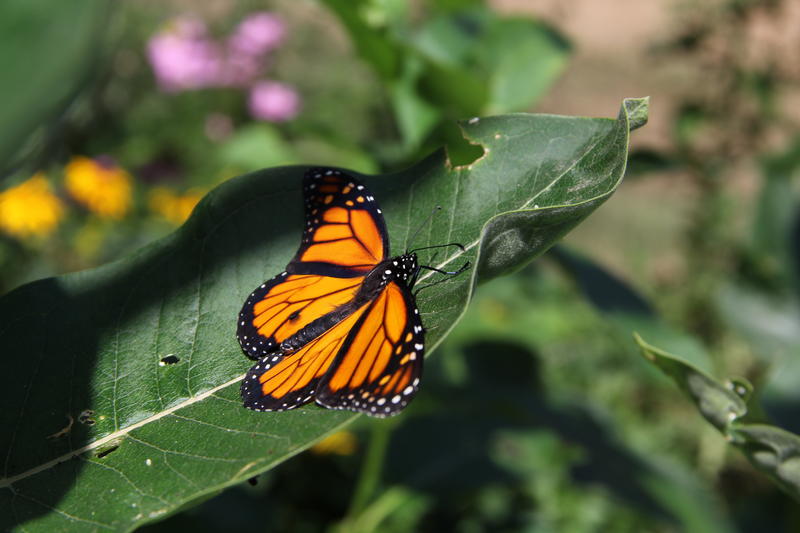
Monarch Butterfly. Photo: Deborah N Champagne, natureupnorth.org
What is the population of albino squirrels? (Danny, Grace, Greg, Steve, Sarah)
Dear Danny, Grace, Greg, Steve, and Sarah,
That was a great question you asked, and I’m glad I can help answer it! Albinism in mammals is caused by a rare genetic trait that causes a complete lack of melanin, a dark pigment found in the skin, hair, and eyes. Not all white squirrels are albino – most are actually leucistic. Leucistic animals have a partial lack of melanin. You can tell an albino squirrel from a leucistic one by the color of their eyes – in albino squirrels they are red. The percentage of white squirrels in the total population is not known, but it appears to be higher in some places than others. In the town of Brevard, North Carolina, 1/3 of the squirrels are white! White squirrels may be more vulnerable to predators, since it is harder for them to camouflage themselves, especially in summer. We fairies believe seeing a white squirrel is good luck, so I hope you find one!
What is your favorite tree to live in? (Mason, age 3)
Dear Mason,
Hi, and thanks for asking your question! Maple trees are my favorite. I love to live in maple trees, because the leaves are big and comfy to sleep in, and the sap is sweet and delicious. I am sure you have eaten maple syrup, and I love it too! Have a good winter!
Dear Fairy, Can you fly? Also, what do you eat? (Mac)
Hi Mac!
Fairies can fly! Just like you can run, bike, or drive to get around, we fly. Our wings are very thin and small, so we try to take lots of breaks. That is why we took a stop in the North Country on our way south. As far as food goes, we eat many things that we find in the forest, and you can read more about it in other answers below. Thanks for getting in touch.
Do fairies like pickles? (Abby, age 11)
Hi Abby!
I’m sure fairies would like pickles if we had them! We only eat food we find in the forest, and pickles don’t grow in the wild. Fairies aren’t too picky though, so I bet if you like them, we would as well. I hope I get to try them someday. In some of the answers further down you can read more about the types of food we can find in the forest.
Dear fairies- Where do you get your food? Love, (Emily Age 7)
Hi Emily!
Fairies are foragers, which means that we don’t plant, farm, or buy our food like you do; we look for it instead. It is like a scavenger hunt! Our food comes from all around the forest. If you look further down, some of the other answers talk about these types of foods that we love to eat. Thank you so much for asking about us; we love to hear from you.
What do fairies eat? (Ethyn H., age 4; Logan Hance, age 9; Keirra, age 5; Greyson, age 3; Delaney age 1)
Hello everyone!
Wow, lots of interest in what we eat! That’s great, because we love food. We eat lots of things that you can find in the forest, such as acorns, berries, mushrooms, and leaves. We use nectar (the sweet liquid in flowers), maple sap, honeydew from aphids, and honey from beehives to sweeten our food. I also love to chew on wild mint and wood sorrel, a plant with leaves that look like bright green hearts, for some great flavors.
How do bees make their honey? P.S. When is your birthday? (Avery, age 3)
Hi Avery!
Bees make their honey from nectar! Nectar is the sugary liquid in flowers. Bees also collect pollen, but that is mixed with honey and fed to baby bees. So, once the bees come back to the hive with nectar, they either store it in the honeycomb for later or pass it from bee to bee in their mouth to turn it to honey. When the bees swallow the nectar it goes to a separate place than their food. In this “stomach” enzymes (special ingredients the bee has in its body) break down the sugars in the nectar into little pieces. When they throw up the nectar and pass it to another bee, the same thing happens in that new bee’s stomach. The bees pass the nectar many times. Then, it goes to be stored in the honeycomb where bees fan it with their wings to help thicken up the honey. Bees generally have to fly 55,000 miles and visit 2 million flowers in total in order to make 1 pound of honey. Aren’t you glad the bees make honey for us? Thank you for such a great question.
P.S. My brother and I were born August 9th, 2003. We are twins!
Why do bees like to sting? (Roman, age 4; Connor, age 10)
Dear Roman & Connor,
Bees do not like to sting. In fact, one of my best friends is a bee. His name is Buzz, and he told me that bees only sting people when they get really mad. As long as you are nice to bees they will be nice to you. Whatever you do, do not try to hit or destroy a bees’ home. That makes them really mad and they will want to sting you. Make sure you stand still when near a bee so that he/she doesn’t think you’re an enemy. Bees like Buzz are mostly just busy trying to find food, so if you stay out of their way they will stay out of yours.
Do bears really eat honey? (Lainey, age 3)
Hi Lainey!
That is a great question. According to my friend Elizabeth, bears do eat honey. That is not all they eat though. When bears raid beehives, they typically eat some of the bees in the hive too. Not only do they eat them, they eat food that is totally unrelated to bees and honey. In the North Country there are black bears that generally eat berries, acorns, beech nuts, and meat from animals like deer. I’ve even seen bear scat (their poop) filled with apples! I hope you continue to get outside and ask great questions.
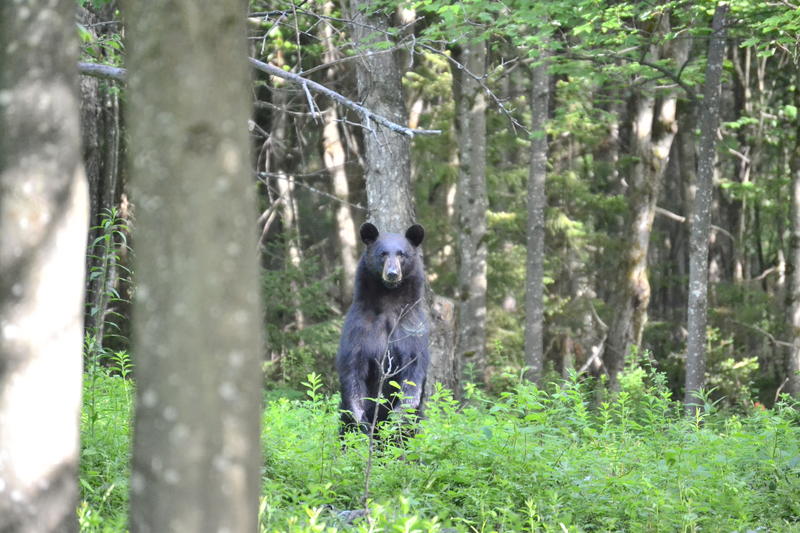
Black Bear. Photo: Carla Jean LaFave, natureupnorth.org
Does moss always grow on the north side of trees? (Jacob, age 28)
Hi Jacob!
Moss frequently grows on the north side of trees but not always. Moss simply grows in whatever environment best supports it. Moss needs a lot of water for it to be able to make more moss grow, so it tends to be found in cooler and wetter environments. Due to way the sun shines down on the Earth in the northern hemisphere, the southern sides of trees get more sunlight. This generally leaves the north side cooler and wetter than the south side. However, on slopes, trees tend to grow leaning down the hill. This causes the water to run down the downhill side. In cases like this, rainwater gathers in the leaves and runs down the trunk, which is called stemflow. So if the tree was on a south-facing slope, the moss may be on the south side instead of the north due to the stemflow on the southern side. Thanks so much for asking, and good luck in all your future outdoor adventures!
What planet are you from? How is the environment? (Connor, age 10)
I am from planet earth, just like you. The environment isn’t doing great. Humans have been using a lot of an invisible gas called carbon. This gas gets stuck in the atmosphere, and it is causing the earth to become hotter, which stresses lots of my plant and animal friends. The environment is also dirty. People don’t always dispose of trash and chemical in the right ways. To help the environment, make sure you are putting trash in the right place. Also, don’t leave lights on when you don’t need to, and don’t leave water running when you’re not using it. These are only a couple ways to help—there are many more! However, little things like this will make the environment a better place for you, us fairies, and all of our friends in the forest.
What is the coldest temperature Canton has ever been? (Hannah & Laura)
Dear Hannah & Laura,
The coldest temperature in Canton was -41 degrees. This happened in January 1925. Luckily, I was not around for that. Us fairies do not like when it’s that cold. That’s why we migrate south every year!
Thanks for tuning in! Look for more fairy houses around the woods of the North Country next year!

